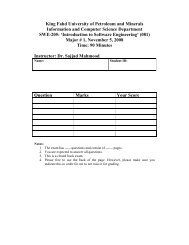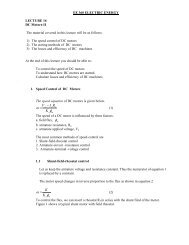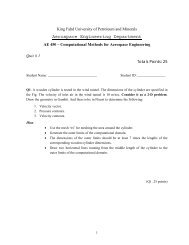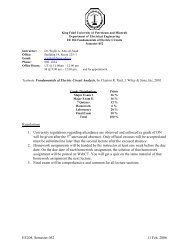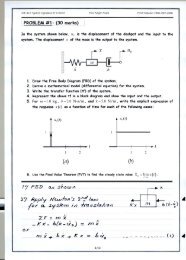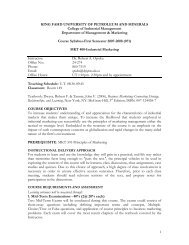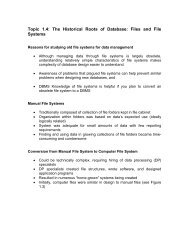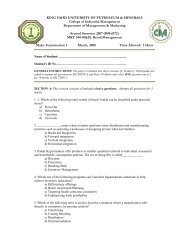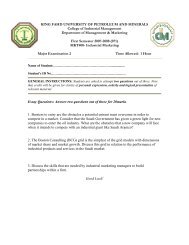Lecture 10(pdf) - KFUPM Open Courseware
Lecture 10(pdf) - KFUPM Open Courseware
Lecture 10(pdf) - KFUPM Open Courseware
You also want an ePaper? Increase the reach of your titles
YUMPU automatically turns print PDFs into web optimized ePapers that Google loves.
EE 370 Chapter IV: Amplitude Modulation <strong>Lecture</strong> <strong>10</strong><br />
Double Sideband Suppressed Carrier (DSBSC) (Continuation)<br />
The modulation and demodulation technique discussed last lecture require the existence<br />
of high quality multipliers (usually called mixers in communication applications). The<br />
use of multipliers is generally undesirable for reasons that are beyond the scope of this<br />
course. So, we need to find DSBSC modulation techniques that do not depend on<br />
multipliers.<br />
To avoid the use of multipliers, several multiplier-less methods exist.<br />
Non–Linear Modulators<br />
In the following block diagram for DSBSC modulation, the message signal m(t) with a<br />
BW of 2πB rad/s and the carrier signal c(t) = cos(ω C t) are not multiplied, but are added<br />
the upper path and subtracted in the lower path.<br />
The signals x 1 (t) and x 2 (t) therefore are<br />
x1<br />
( t)<br />
= c(<br />
t)<br />
+ m(<br />
t)<br />
= cos( ωCt)<br />
+ m(<br />
t)<br />
.<br />
x ( t)<br />
= c(<br />
t)<br />
− m(<br />
t)<br />
= cos( ω t)<br />
− m(<br />
t)<br />
1<br />
C<br />
These signals are passed through two exactly similar non–linear devices that have scale<br />
there input signals and add it to a scaled version of the square of their input signals.<br />
So,<br />
y ( t)<br />
= a<br />
1<br />
y ( t)<br />
= a<br />
2<br />
[ cos( ω t)<br />
+ m(<br />
t)<br />
] + b[ cos( ω t)<br />
+ m(<br />
t)<br />
]<br />
2<br />
= am(<br />
t)<br />
+ bm ( t)<br />
+ 2bm(<br />
t)<br />
⋅cos(<br />
ω<br />
123 123<br />
Ct)<br />
+ a cos( ωCt)<br />
+<br />
144244<br />
3 14243<br />
Undesired<br />
[ cos( ω t)<br />
− m(<br />
t)<br />
] + b[ cos( ω t)<br />
− m(<br />
t)<br />
]<br />
2<br />
= − am(<br />
t)<br />
+ bm ( t)<br />
− 2bm(<br />
t)<br />
⋅cos(<br />
ω<br />
123 123<br />
Ct)<br />
+ a cos( ωCt)<br />
+<br />
144244<br />
3 14243<br />
Undesired<br />
C<br />
2<br />
= a cos( ω t)<br />
+ am(<br />
t)<br />
+ bm ( t)<br />
+ 2bm(<br />
t)<br />
⋅cos(<br />
ω t)<br />
+ bcos<br />
C<br />
C<br />
C<br />
Undesired<br />
Undesired<br />
Desired<br />
C<br />
C<br />
Desired<br />
C<br />
Undesired<br />
C<br />
Undesired<br />
b<br />
{ 2<br />
Undesired<br />
2<br />
= a cos( ω t)<br />
− am(<br />
t)<br />
+ bm ( t)<br />
− 2bm(<br />
t)<br />
⋅cos(<br />
ω t)<br />
+ b cos<br />
2<br />
2<br />
2<br />
2<br />
b<br />
+ cos(2ωCt)<br />
14243 2<br />
b b<br />
+ cos(2ωCt)<br />
{ 2 142 2 43<br />
Undesired<br />
( ω t)<br />
C<br />
( ω t)<br />
C<br />
Undesired<br />
Undesired
EE 370 Chapter IV: Amplitude Modulation <strong>Lecture</strong> <strong>10</strong><br />
z t)<br />
= y ( t)<br />
− y ( t)<br />
(<br />
1 2<br />
= 2am(<br />
t)<br />
+ 4bm(<br />
t)<br />
⋅ cos( ω<br />
123<br />
Ct)<br />
144244<br />
3<br />
Undesired<br />
Desired<br />
The sum (or actually the different) of the outputs of the two non–linear devices contains<br />
two terms that can be described as follows:<br />
2am ( t)<br />
is the original message signal. This is an UNDESIRED<br />
BASEBAND signal with bandwidth BW = 2πB rad/s.<br />
4bm(<br />
t)<br />
⋅ cos( ω t)<br />
is the message signal multiplied by the carrier. This is the<br />
C<br />
DESIRED signal with frequency centered around ±ω C .<br />
It is obvious that since the desired signal 2bm(<br />
t)<br />
⋅ cos( ω t)<br />
occurs around ±ω C , we can<br />
use a BPF with a passband region centered around ±ω C and BW = 4πB rad/s (or 2B Hz)<br />
to allow this signal and reject the first component 2am(t).<br />
Notes:<br />
• Many non–linear devices exist such as transistors and diodes. These devices<br />
operate non–linearly around their biasing regions. The non–linearity of these<br />
devices may be in the form of an exponential relationship that can be<br />
approximated as a square relation for signals with low amplitudes in specific<br />
operation regions of these devices.<br />
• The modulation system shown above can be used for demodulation too. Just<br />
replace the BPF with a LPF of BW = 4πB rad/s and feed the carrier signal to one<br />
input and the DSBSC modulated signal to the other input. (Exercise: show that the<br />
output of that system is a scaled version of the message signal)<br />
• The following block diagram is a simpler DSBSC modulator, where the non–<br />
linear device has a = 0 (Exercise: verify that this system is able to do DSBSC<br />
modulation). However, this system can be used for demodulation only if the<br />
magnitude of the message signal is significantly small such that the square of that<br />
signal is much lower (and therefore can be ignored) than the magnitude of the<br />
message signal.<br />
C
EE 370 Chapter IV: Amplitude Modulation <strong>Lecture</strong> <strong>10</strong><br />
Switching Modulators<br />
Another type of DSBSC modulator/demodulators is switching modulation. The idea of<br />
switching modulation is the other carriers such as “square waves” can be used instead of<br />
sinusoidal waves to modulate the message signal. Since a square wave can be represented<br />
in terms of a sum of sinusoids with fundamental frequency ω o equal to the frequency of<br />
the square wave. So, if a message signal is modulated using a square wave with<br />
frequency equal to the desired carrier frequency ω C and then this modulated signal is<br />
filtered using a BPF centered at ω C with bandwidth twice the bandwidth of the message<br />
signal, the resulting signal is a DSBSC signal.<br />
The square wave modulation can be performed using one of many configurations:<br />
Diode–bridge and Ring Modulator:<br />
A typical configuration of diode–bridge modulator is shown below, where c(t) =<br />
cos(ω C t).<br />
When c(t) < 0, all diodes are turned off and therefore, the circuit simplifies to<br />
the following<br />
Therefore, the current of the message source m(t) passes through the 1 Ω resistor<br />
and creates a voltage across the resistor that is equal to m(t) Volts. However,
EE 370 Chapter IV: Amplitude Modulation <strong>Lecture</strong> <strong>10</strong><br />
when c(t) > 0, all diodes become forward–biased (they become like conductors),<br />
and therefore the circuit simplifies to<br />
So, all current of the message source passes through the short circuit and no<br />
current passes through the resistor. This leaves the voltage across the resistor to be<br />
zero.<br />
Hence, the signal at the input of the BPF is equal to the message signal when the<br />
carrier is negative and equal to zero when the carrier is positive. This is simply<br />
like multiplying the message signal with a square wave that has a frequency equal<br />
to the carrier frequency. The BPF removes the DC term and all higher harmonics<br />
of this signal resulting in a DSBSC signal at its output.<br />
This circuit can also be used for demodulating the DSBSC signal by feeding this<br />
signal in place of the message signal and replacing the BPF with a LPF.<br />
The ring modulator works in a similar way except that it results in having a<br />
bipolar square wave multiplied by the message signal (see page 159 of your<br />
textbook for details).



